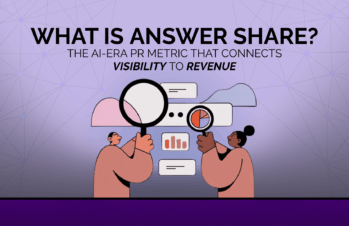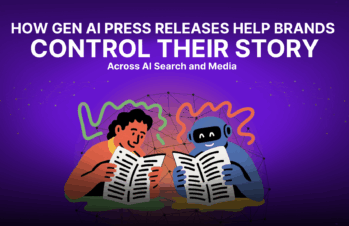In 24 hours, a PR disaster can damage years of trust and hard-earned reputation. In 48 hours, it can destroy it. So, how do you shield your brand from the fallout of a PR crisis before it spirals out of control?
Resilience starts with an established crisis management PR plan—one that outlines an effective marketing strategy for communicating with stakeholders and customers—but that’s not where it ends. There’s another lifeline you’ll need in the world of public relations: earned media.
How does it work? Earned media is a brand ally. It’s an often underutilized asset that can significantly reinforce trust when your brand needs it most.
When you integrate earned media into your broader content marketing strategy, the overall positive perception of your brand gains the power to overshadow the crisis. Accumulating and showcasing a wealth of positive news coverage means that a single negative PR incident won’t dominate customer opinions about your brand.
By proactively building a strong reputation with an earned media strategy, you can protect your brand and give it the power to rally against PR challenges. That fortification includes marketing efforts like:
- press coverage
- social media posts
- product reviews
- blog posts
- user-generated content
- word-of-mouth marketing
- endorsements
…and other organic mentions that favorably highlight your brand.
So, if (or maybe, when) a crisis does occur, here’s what you need to know to tip the scales back in your favor:
What Is Earned Media?
Earned media refers to publicity or exposure that a company earns through word-of-mouth marketing, online reviews (like those seen on social media channels or your website), press coverage, and other forms of media attention that draw organic traffic to your brand. Unlike paid media—which involves advertising, influencer marketing, and other promotional efforts that are paid for—earned media is gained through the merit of a company’s products, services, reputation, and actions.
Related Reading: What is Earned Media? A How-To Guide
One of earned media’s key benefits is its credibility. Earned media exudes a sense of authenticity that subtly encourages people’s view of a brand. For example, potential customers find customer reviews more trustworthy than paid promotions. When a customer shares their genuine satisfaction and positive experience with a company, it carries significant weight. A paid endorsement, on the other hand, can ring hollow.
Similarly, when a publication, review site, or influencer gives a company favorable coverage without being compensated, it lends a level of legitimacy to the brand’s image. This type of recognition often results in a more profound and lasting impact than traditional advertising.
In both cases, the unpaid support of a brand is often perceived as an honest endorsement of quality, satisfaction, or both.
How to Use Earned Media to Mitigate PR Disasters
A PR crisis can seem catastrophic, particularly because bad press can spread so quickly. That negativity can cause serious damage to your reputation and, ultimately, to your bottom line. It’s crucial to have a crisis management plan in place ahead of time so you’re prepared to mitigate the damage and regain your audience’s trust.
Related Reading: Shortening the News Cycle: How to Minimize the Impact of a PR Crisis
First, to effectively leverage earned media and mitigate PR disasters, brands should prioritize building strong relationships with key stakeholders. Those include customers, employees, investors, partners, and the media. Fostering open communication and engaging regularly with these groups helps to build the supportive network you’ll need when you see a PR challenge looming on the horizon.
Related Reading: Internal PR: Why Your Team Matters as Much as Your Customers—and How to Communicate to Them in a Crisis
Second, brands need to be transparent and proactive in times of crisis. That means it’s important to address the issue head-on. By incorporating earned media into your crisis communication plan, you can amplify positive stories and testimonials that showcase your brand’s strengths and values. This can help to counteract negative press and shift the narrative back in your favor.
Leveraging Earned Media During a PR Crisis:
Here are four key ways your brand can leverage earned media during a crisis, as part of a strong crisis management strategy:
- Showcase positive customer testimonials and reviews: Share customer stories that illustrate your brand’s commitment to customer satisfaction and quality. This demonstrates that any negative incident is an isolated occurrence and that it does not reflect the overall experience of your customer base.
- Highlight positive press coverage: Share articles, reviews, thought leadership pieces, and interviews showcasing your brand positively. This offers a balanced view of your brand, reinforcing reasons for customers to trust and support your products or services.
- Engage with satisfied customers: Contact customers with positive brand experiences and encourage them to share their stories publicly. Their endorsements can bolster your credibility and reassure others of your brand’s trustworthiness.
- Address negative press with honesty and transparency: When responding to negative press coverage, offer clear, factual information to correct any misconceptions or inaccuracies. Proactively addressing the issue with transparent communication can help regain your audience’s trust.
It’s all about reinforcing customer confidence. By highlighting positive stories, connecting with customers, and offering transparent communication, your brand can lean on its earned media to demonstrate its commitment to its values while rebuilding trust with your audience.
Build Your Reputation Through Positive Media Hits
Speaking of audience trust, building a positive reputation through media hits is crucial. What’s a media hit? News articles, podcast appearances, blog posts, and interviews are all good examples.
Ultimately, positive media hits are a powerful tool for building and maintaining a strong and resilient reputation.
In fact, they are a significant reason why it’s important to master the “frequency illusion,” also known as the Baader-Meinhof phenomenon. This cognitive bias means once you notice one piece of information, positive or negative, you tend to notice additional information that serves to confirm it afterward. This suggests that the more positive media coverage you receive—no matter the type of content—the more trustworthy and reputable your brand appears to your target audience.
If you have a solid record of positive, high-quality content and media coverage, a single negative review or social post isn’t as likely to significantly damage your reputation. As you build up this positive press over time, you’ll create a buffer for your brand. This buffer can help you overcome larger crises with your audience’s trust intact, or even reinforced.
This is why it’s essential to continuously seek out and generate positive—and preferably, shareable—content. Again, the goal is to build a strong foundation of trust with your audience.
Even better, earned media can significantly enhance a brand’s visibility and search engine rankings. This can lead to increased organic reach and even the potential for viral growth.
By consistently securing valuable content, such as features, interviews, or positive reviews, you can solidify your reputation as a trustworthy and reputable brand. This, in turn, will help you establish an effective shield you can strategically leverage to mitigate any negative press that may come your way.
Utilize Crisis Communication Strategies
A strong crisis communication plan is crucial for reducing the damage of a PR disaster. One of the most powerful things you can do is to respond promptly and transparently to any negative press or social media backlash. By confronting the issue directly and taking responsibility for any mistakes, brands can minimize long-term damage to their reputation.
So, when it comes to earned media, a crucial strategy in PR crisis communication is to leverage your positive assets while you share your perspective. Contact trusted media outlets and influencers who have positively highlighted your brand before. Ask them to share their perspective and experiences. By securing additional positive coverage during a crisis, you can help shift the narrative and regain control over public perception.
Related Reading: Navigating Crisis Management in the Digital Age
Engage with Your Audience on Social Media
Of course, social media is a powerful tool for engaging with your audience during a PR crisis. Monitor your social channels closely to stay informed of any negative press or backlash. And, as mentioned above, always respond promptly to address any concerns. Leveraging your social media platforms isn’t just a good way to connect directly with your audience. It’s also a great way to humanize your brand. That personal touch and authenticity helps to maintain loyalty and engagement, while providing a platform for you to share your side of the issue.
Engaging with your audience through your social platforms demonstrates that you are attentive and actively working to address the problem. Encourage feedback, respond to comments and messages, and provide timely updates. This will keep your audience informed, engaged, and involved. Cultivating your relationship with your audience on social media is key to restoring trust and upholding a strong reputation, helping to reduce the impact of any negative press.
Be Open and Honest
In the midst of a PR crisis, it’s important for brands to adopt a proactive and transparent approach to communication. Swiftly addressing the issue and acknowledging any missteps showcases a brand’s dedication to resolution, and it goes a long way toward restoring trust with its audience. Steer the narrative with honesty and directness. In this way, a brand can use its crisis communication to not only effectively convey a commitment to rectifying the situation, but to also clearly demonstrate that they sincerely value their audience’s concerns.
The importance of transparency and sincerity simply cannot be overstated. These are crucial elements for safeguarding a strong reputation and effectively navigating a PR disaster. Demonstrating to your customers that your brand operates with integrity and has nothing to hide has the power to significantly boost trust. This strategy not only helps brands manage negative publicity but also strengthens their relationship with their audience. This has the potential to expand a brand’s reach, enhancing rather than tarnishing their image in the public eye. This approach involves not just admitting to faults but also actively engaging with the affected parties to seek solutions, ensuring that actions speak as loudly as words.
Nurture Industry Relationships
Positive PR is an essential aspect of brand reputation management. By engaging proactively and positively with earned media, brands can establish themselves as responsible and trustworthy members of the communities they’re involved in. Beyond just responding to media inquiries, it’s vital for brands to actively seek ways to highlight their positive impacts and contributions
Building media relationships is important in this process, as these connections enable brands to effectively convey their messages in ways that engage and resonate with the public. Strategies can include pitching stories, offering exclusive coverage rights during product launches, and sharing valuable insights. Creating a strong rapport with the media not only increases the likelihood of positive coverage in the future, it also fosters goodwill and trust.
Overall, practicing positive PR is about cultivating a beneficial brand image and good reputation. This open commitment to a brand’s mission and customers can also create a ripple effect, impacting customer acquisition, employee morale, investor confidence, and customer loyalty.
The Power of Earned Media
Leveraging earned media in the face of a PR crisis is a strategic approach that emphasizes the importance of building a solid reputation through positive, credible media coverage. By proactively engaging with all forms of earned media—customer testimonials, press coverage, and social media mentions—a brand can significantly mitigate the negative impacts of a crisis and reinforce trust with its audience. This strategy relies on transparency, open communication, and a commitment to authenticity, showcasing a brand’s integrity and dedication to customer satisfaction. Ultimately, the effective use of earned media not only helps a brand navigate through challenging times but also strengthens its relationship with stakeholders, ensuring long-term resilience and trustworthiness in the public eye.Want help garnering that coveted press coverage? Reach out—we’d love to help you build your brand with a digital marketing strategy.




